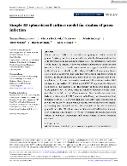Simple 3D spheroid cell culture model for studies of prion infection

Autor
Datum vydání
2024Publikováno v
European Journal of NeuroscienceRočník / Číslo vydání
60 (4)ISBN / ISSN
ISSN: 0953-816XISBN / ISSN
eISSN: 1460-9568Metadata
Zobrazit celý záznamKolekce
Tato publikace má vydavatelskou verzi s DOI 10.1111/ejn.16444
Abstrakt
Mouse neuronal CAD 5 cell line effectively propagates various strains of prions. Previously, we have shown that it can also be differentiated into the cells morphologically resembling neurons. Here, we demonstrate that CAD 5 cells chronically infected with prions undergo differentiation under the same conditions. To make our model more realistic, we triggered the differentiation in the 3D culture created by gentle rocking of CAD 5 cell suspension. Spheroids formed within 1 week and were fully developed in less than 3 weeks of culture. The mature spheroids had a median size of ~300 μm and could be cultured for up to 12 weeks. Increased expression of differentiation markers GAP 43, tyrosine hydroxylase, β-III-tubulin and SNAP 25 supported the differentiated status of the spheroid cells. The majority of them were found in the G0/G1 phase of the cell cycle, which is typical for differentiated cells. Moreover, half of the PrPC on the cell membrane was N-terminally truncated, similarly as in differentiated CAD 5 adherent cells. Finally, we demonstrated that spheroids could be created from prion-infected CAD 5 cells. The presence of prions was verified by immunohistochemistry, western blot and seed amplification assay. We also confirmed that the spheroids can be infected with the prions de novo. Our 3D culture model of differentiated CAD 5 cells is low cost, easy to produce and cultivable for weeks. We foresee its possible use in the testing of anti-prion compounds and future studies of prion formation dynamics.
Klíčová slova
cell differentiation, neuronal cells, prion infection, prion protein, PrP, spheroid culture
Trvalý odkaz
https://hdl.handle.net/20.500.14178/2688Licence
Licence pro užití plného textu výsledku: Creative Commons Uveďte původ 4.0 International







